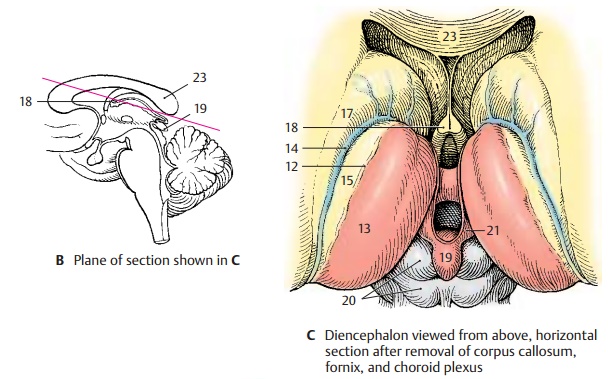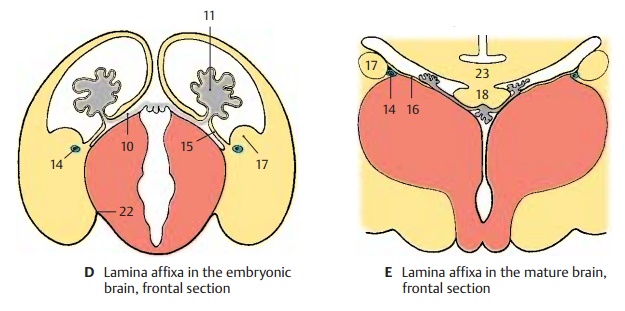Chapter: Human Nervous System and Sensory Organs : Diencephalon
Telodiencephalic Boundary

Telodiencephalic Boundary
Only the floor of the diencephalon is visible at the surface of the brain; it forms the opticchiasm, the tuber cinereum, and the mamil-lary bodies at the base of the brain. The roof of the diencephalon becomes vis-ible only after cutting horizontally to re-move the corpus callosum (B). This exposes the roof of the third ventricle and the two thalami. The entire region is covered by avascularized connective tissue plate, the tela choroidea (D10), the removal of whichopens the third ventricle (C). Over the third ventricle and in the medial wall of the hemi-sphere, the brain tissue is extremely thin and becomes invaginated into the ventricu-lar cavity by protruding vascular loops. The vascular convolutions lying in the ventricle form the choroid plexus (D11) (production of cerebrospinal fluid). Upon removal of tela choroidea and choroid plexus, the thinned wall of the cerebral hemisphere is torn away and only the sepa-ration line remains as the choroid line (C12). The surface of the thalamus (C13) becomes exposed up to this separation line, while it is still covered laterally by the thinned wall of the hemisphere. The segment of the thinned wall of the hemisphere between the attachment of the plexus and the thalamostriate vein (C–E14) is called thelamina affixa (CD15). It adheres to the dorsalsurface of the thalamus and fuses with it in the mature brain (E16). The thalamostriate vein (C – E14), which runs between thalamus and caudate nucleus (C – E17), marks the boundary between diencephalon and telencephalon when viewed from above.
BCE18 Fornix.
BC19 Epiphysis.
C20 Quadrigeminal plate.
C21 Habenula.
D22 Telodiencephalic fissure.
BCE23 Corpus callosum.


Related Topics